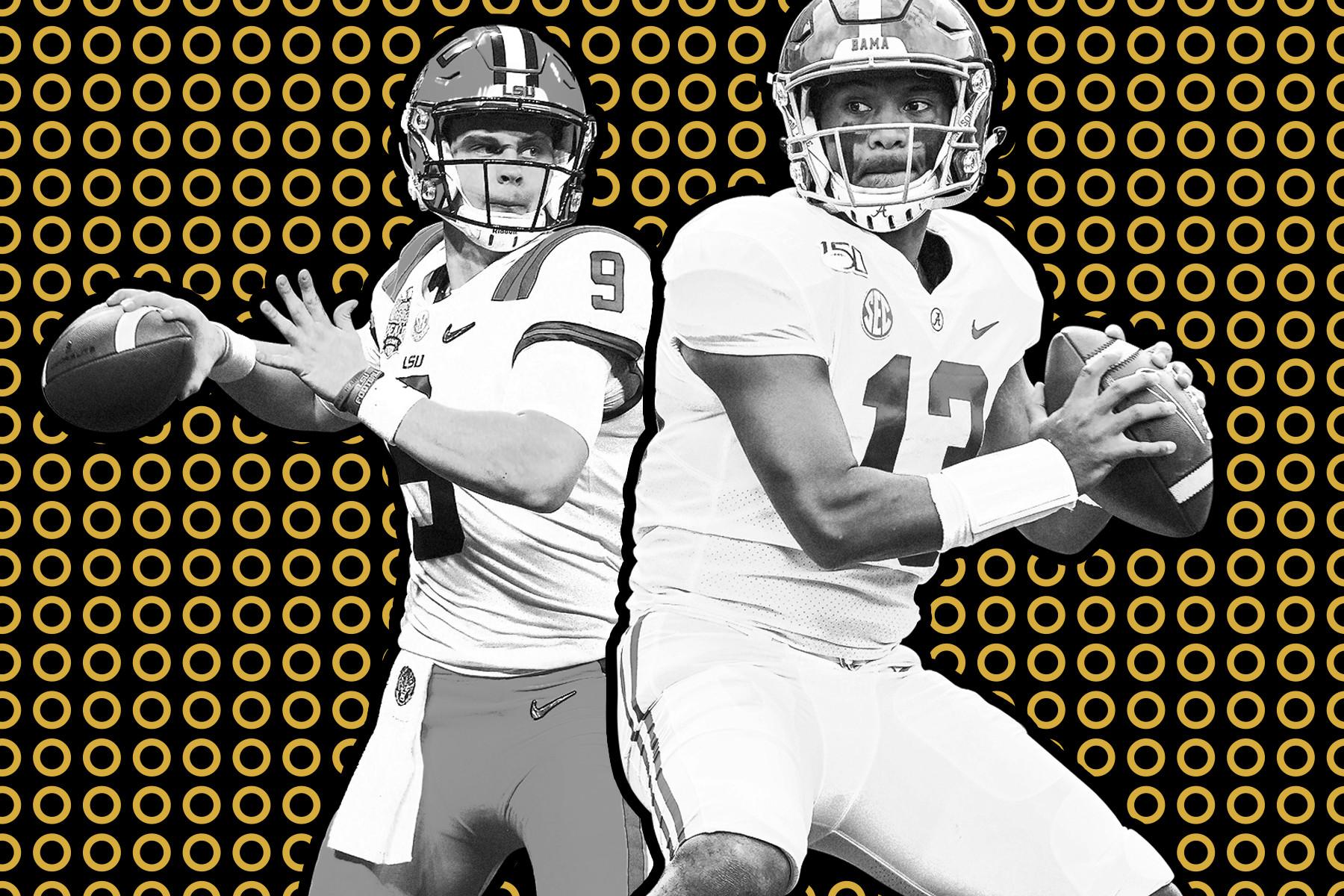
On Thursday, NFL draft host Trey Wingo will arrive at ESPN’s campus without the strut of a first-round pick. At the security gate, Wingo won’t just show his ID badge. By mandate of the state of Connecticut, he’ll carry a letter from the legal department saying he has permission to enter. Inside, Wingo will walk past bottles of Purell, past exterior bathroom doors that have been propped open so ESPN employees won’t touch the handles on the way inside.
Wingo will skip the greenroom. “There could be four or five people congregating,” he said, “and that is a faux pas right now.” ESPN sent its makeup artists away, so Wingo’s work-from-home tan will have to suffice. On the set, Wingo will be virtually alone—Mel Kiper Jr. is beaming in from Maryland, Adam Schefter from Long Island. When producer Bryan Ryder speaks to Wingo from the control room, Ryder will speak through a protective mask.
This sounds like a preview of what America will look like when the economy reopens. In fact, the NFL’s economy has never closed. The NFL’s offseason is resistant to the coronavirus. This week, Roger Goodell won’t be booed by 750,000 fans in Las Vegas. But when Goodell decided to administer the draft from his Bronxville, New York, basement, those boos became a branding opportunity for Bud Light Seltzer (the proceeds going to charity, naturally).
The defiant normalcy of the draft during a worldwide pandemic is weird. Maybe more than weird. Here’s one way to think about it: After the coronavirus inflicted economic hell on writers from Sports Illustrated and SB Nation, this year’s draft will function as a sports media stimulus package. You don’t need to think the NFL is a cuddly corporate force, or think most draft coverage is terribly important. But if a debate about Tua Tagovailoa’s hip keeps a few people employed, it’s probably worth having.
For more than a month, American culture has existed on a split screen. On one hand, movies and theater and travel and every other sport ground to a halt. On the other, the NFL and its insiders carried on as if the coronavirus were a minor medical story.
On the morning of March 15, The New York Times led with this headline: “Europe Locks Up and Faces Crisis As Virus Spreads.” The big story on sports Twitter was the Jaguars’ trade of Calais Campbell for a fifth-round pick. On April 2, the Times led with a Harvard economist calling the Great Recession of 2008 a “dry run” for the 2020 edition. That day, the Chiefs’ Twitter account reported that Andy Reid was grinding tape.
There are people in the NFL community, like the agent Buddy Baker, who have seen loved ones suffer the horrific effects of the virus. But NFL content has become a place where minor inconveniences get a heroic glow-up. This month, Colts GM Chris Ballard said there’d be a 30 for 30 documentary about the 2020 draft because … GMs are picking the players from home rather than from team headquarters. Chris, thank you for your service.
In the NFL, no one is allowed to entertain doubts about whether having a draft is the right thing to do. After a committee of GMs urged the league to delay the draft (many simply wanted more time to prepare), Goodell wrote in a memo that “public discussion of issues relating to the Draft serves no useful purpose and is grounds for disciplinary action.” In the NFL, the draft is never criticized and apparently always capitalized.
According to historian Michael MacCambridge, the NFL’s offseason became a content machine for journalists in three stages. In 1959, the AFL formed and started competing with the NFL to sign players. In 1976, the NFL moved the draft from January to April—allowing teams more time to study prospects and creating a content runway that birthed a generation of draftniks. In 1993, the league belatedly welcomed free agency.
These changes improved the employment prospects of just about everyone who writes or talks about pro football. They now had year-round jobs. (More than 11 million people watched the first round of last year’s draft on three networks.) The supersized NFL offseason also created a kind of codependency. As the league created more and more events—the combine, the schedule release—football writers had to over-cover them, lest they get left behind.
Case in point: On March 16, the NFL was set to kick off its “legal tampering” period. That morning, ProFootballTalk’s Mike Florio tweeted that by unleashing transactions during a pandemic the league was making its “biggest mistake since playing games two days after the JFK assassination.” Florio spent the afternoon reporting on all the new contracts. One way or another, the NFL doesn’t tolerate dissent.
When thinking about how the NFL draft plays during a pandemic, it’s important to distinguish between “bad optics” and something that’s actually bad. If Major League Baseball wants to stick its players in an Arizona biodome, there are legitimate questions about safety and logistics. The NFL draft is a TV show. If it’s not OK to roll out new shows during a pandemic, we should probably also cancel The Plot Against America, Devs, and Trolls World Tour.
There’s a decent argument that events like the draft offer an opportunity to look away from the grim death toll that’s on CNN every day. “I haven’t felt a ton of, ‘I can’t believe they’re doing this,’” said Wingo. “From the sports fans that I interact with and talk to, a lot of them are like, ‘Thank God I’ve got at least something that makes me feel like there’s a little bit of normalcy in my life.’”
You can push this idea too far. I don’t think the draft is a “beacon for a wounded country.” I sigh when I think about how the league will honor the “real heroes” Thursday night. But everybody needs a break from Chris Cuomo.
The best case for going all in on the draft is its role as a journalistic job maintainer. I’ve written that the coronavirus and the accompanying ad crunch may be the first economic crisis that singles out sportswriters for pay cuts and layoffs simply because they have less to cover.
From the sports fans that I interact with and talk to, a lot of them are like, ‘Thank God I’ve got at least something that makes me feel like there’s a little bit of normalcy in my life.’Trey Wingo
According to Seth Markman, an ESPN executive who oversees NFL studio programming, around 250 people at the network are involved in covering the draft in some way. It’s not just Wingo and Kiper. Content associates—a.k.a. entry-level TV employees—put together player highlight packages. The network’s creative services team goes to the combine and films Tagovailoa tossing a football in the air to create a “bump” that will play when he gets picked.
NFL Media estimates it has more than 200 people working on draft content. Bleacher Report has more than 20 working on a draftcast that will air on its B/R app.
In a time without games, stories about the draft have offered a stimulus to just about every sports website with sagging readership, every radio show and podcast with sagging listenership, every newspaper that’s blowing apart like a supernova during the ad crunch. This week, my downsized Los Angeles Times sports section has been filled with miniprofiles of prospects like Kristian Fulton and Javon Kinlaw.
Hardcore draftniks need the draft content stream most of all. Matt Waldman, who publishes a guide that helps readers pick the next fantasy stars, said sales haven’t dipped this year during the coronavirus. That allows Waldman to continue working full time as a football writer, which is no small thing. “I’m not doing anything massively important,” Waldman told me. “I know that. But it’s important to me and my family.”
To see the draft as a job maintainer, you don’t need to think the NFL is doing a solid for journalists except by accident. The NFL likes coverage because coverage helps the league make money. Such coverage may even marginally tighten the NFL’s already fierce grip on American life. But short of discovering the Joe Burrow of kindly billionaires, I don’t have a better solution for sportswriters to get through the next few months. Athletic writers can get “weird” only so many times, and we’re all going to run out of things to say about The Last Dance.
The NFL’s great trick with the draft is making failure the basis for a hit TV show. Bengals fans will watch Thursday night because they might see the beginning of a renaissance. Switch up the metaphor slightly and you have a case for the draft itself. Draft content offers a small hope of future success, or at least survival. The media is the Bengals.


